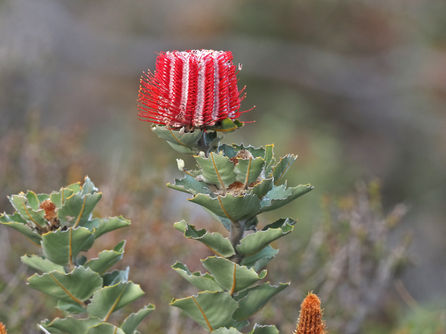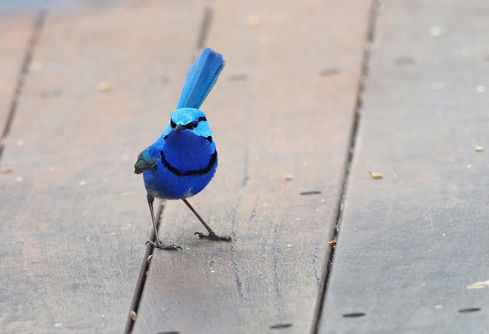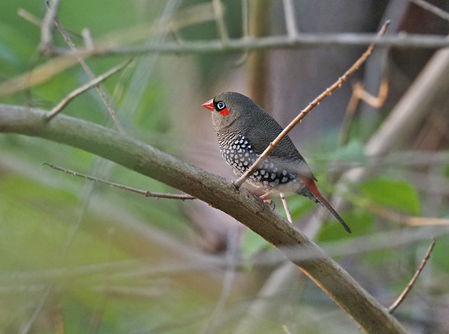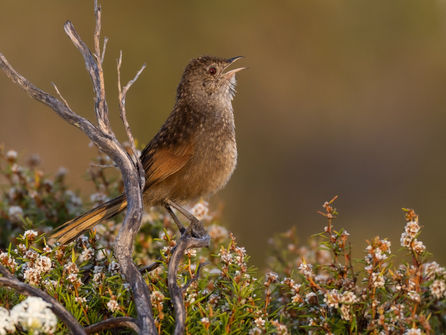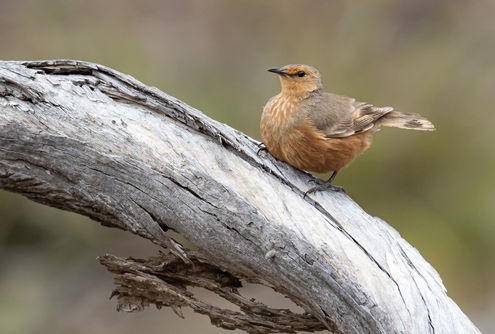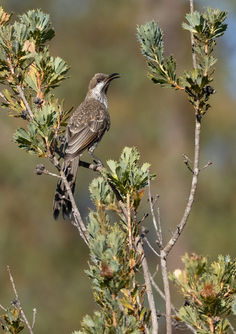
Western Australia: Southwest Specialties
Tour Overview:
After the Eastern Australian season begins to wind down, Western Australia comes into its own. This tour can be done as an extension to our Eastern Australia tour, or as a stand-alone tour for those only seeking the specialties of the southwest – there are 15 endemic birds to look for after all! In this season, there can also be vast blooms of other-worldly flowers scattered within the coastal heaths, woodlands and forests, bringing them alive with nectar-feeding birds such as honeyeaters, which abound in this country-come-continent. Some mouthwatering targets include Western Spinebill, two species of enormous black-cockatoos, Red-winged and Blue-breasted fairywrens (alongside the decidedly common Splendid Fairywren), the western form of Crested Shrike-Tit, and the famous “Western Tough Trio” of Western Bristlebird, Western Whipbird and Noisy Scrub-Bird. There is also a chance for a Malleefowl and superb mammals too, like the abundant Western Grey Kangaroo, and two major regional scarcities, Numbat and Honey Possum, although some fortune is required for the last two! This region is wonderfully scenic, overlooked, and scandalously under-appreciated sector of the vast Australian network of high-quality birding areas!
Upcoming Departures:
2022
1 - 8 November ($AUD 7700)
Other Tour Information:
Length: 8 Days
Starting City: Perth
Ending City: Perth
Pace: Moderate
Physical Difficulty: Moderate
Focus: Birding
Max group size: 8 + 1 leader
*This tour links with
EASTERN AUSTRALIA: From Top to Bottom
Detailed Itinerary
Day 1: Arrival in Perth
After your arrival and transfer to our Perth hotel, we will meet for dinner to start the tour.
Day 2: Perth to Dryandra
Just outside of the city lies the wonderful Victoria Dam, an excellent birding site, which will quickly yield a bunch of our southwest specialties. When there are blooming banksias and other native plants, the area can be alive with nectarivores, including some regional endemics, like Western Spinebill, Western Wattlebird, and Gilbert’s Honeyeater. Other specialties we will be seeking include Western Whistler, the beautiful Red-capped Parrot, Red-winged Fairywren, Western Thornbill and Carnaby’s Black-Cockatoo. The supporting cast is equally impressive with the distinctive '28-form' of Australian Ringneck and Red-tailed Black-Cockatoo as regulars, and it is likely will see our first spectacular Splendid Fairywrens in this area, which are absurdly abundant in southwest Australia. We will also keep an eye out overhead, as Square-tailed Kite, a scarce Aussie raptor, frequents the area too. After lunch, we will head south to Dryandra for the afternoon, one of Western Australia’s most revered birding sites. As we make our way south of Perth, we will check a few sites with Jarrah woodland for the scarce Baudin’s Black-Cockatoo. The night will be spent in nearby Narrogin.
Day 3: Dryandra to Stirling Ranges NP
We will have already sampled some of the birds of the southwest the afternoon before, but Dryandra is well worth an extensive sweep, occupying the whole morning. Dryandra and Narrogin are home to mixed Marri, Jarrah, Mallet, Sheoak and Wondoo woodlands, which are special to the southwest. Some of the most notable birds include Square-tailed Kite, Painted Buttonquail, Rufous Treecreeper, Blue-breasted Fairywren, Regent Parrot, Purple-crowned Lorikeet, Western Rosella, Red-capped and Scarlet Robins, and Western Yellow Robin. The rare Numbat, a very odd Aussie mammal, is found in the temperate woodlands around Dryandra, and while birding, we will hope to get extremely lucky with this one! In the afternoon, we make our way to the wonderful Sterling Ranges National Park for a two-night stay, located within the only major mountain range within southern Western Australia. The route there passes through excellent parrot country, with sometimes incredible numbers of Australian Ringnecks, Red-capped and Regent Parrots within the agricultural matrix studded with pockets of wooded areas.
Day 4: Corackerup Nature Reserve and Stirling Ranges National Park
During the morning we shall take an early morning trip out to a small area of mallee at Corackerup Nature Reserve. Our hope will be to find that Australian habitat's most famous resident, the Malleefowl. Even if we fail to see Malleefowl, the area holds another southwest specialty, Western Whipbird, as well as being home to Purple-gaped and Tawny-crowned honeyeaters Western Wattlebird, Shy Heathwren, and Southern Scrub-Robin. In the afternoon, we will explore the Stirling Ranges, checking heathy areas for Western Fieldwren, and scouring campsites for birds like Carnaby’s Black-Cockatoo, Elegant Parrot, “Western” Crested Shrike-Tit, and White-breasted Robin. At night we can search for Australian Owlet-Nightjar, Barn Owl and Southern Boobook.
Day 5: Stirling Ranges to Cheynes Beach
Following some final birding around Stirling Ranges, we shall make a detour to visit a very good area for Western Corella, around Rocky Gully, an area that also offers up another shot at Baudin’s Black-Cockatoo. We then switch back south towards the coast, for a two-night stay at the scenic Cheynes Beach. On the journey south, we will check coastal sites for Australian shorebirds and particularly for Fairy Tern. At night, we can search the local coastal heathland on foot, to check for flowering banksias, and to see if any Honey Possums are in attendance.
Day 6: Cheynes Beach and surrounds
This day will be dedicated to the area's three infamous skulking specialties – Western Whipbird, Noisy Scrub-Bird and Western Bristlebird. None of them are easy, but they are all found within a relatively small area, so we can try a range of spots around the local coastal heaths. These are also home to Brush Bronzewing, Red-eared Firetail, and the local coastlines can be good for Rock Parrot too. A second night will be spent at Cheynes Beach.
Day 7: Cheynes Beach to Perth
This is something of a “flexi day”, as we can have another go at the local heath skulkers if we missed them the day before, but we will also be returning north, through many areas already covered, and passing by numerous excellent birding areas, so we will pick our spots carefully to plug any gaps if needed, or simply continue to add more bird species. If we need Banded Stilt, we may hit a coastal site, although if we are seeking woodland or heathland birds, we have the chance to do that too. The final night of the tour will be spent at a hotel near Perth airport.
Day 8: Departures from Perth
There is no birding scheduled on this day, so feel free to leave whenever suits you.
Trip Considerations
PACE: Moderate. This tour targets specialist birds, and in order to do so it will involve early starts, at around 5:00am. There are a number of long drives on this tour, with some short sections of these on good, unpaved roads. A 4 x 4 vehicle however is not required.
PHYSICAL DIFFICULTY: The walks on this trip are mostly easy, not involving any steep gradients or elevations, but will be on rocky and uneven ground at times.
CLIMATE: The climate on this trip will be mostly a hot dry heat in the Outback, which forms the main part of the tour. In this season, the daytime temperatures range from around 15-32 Celsius (60-90 Fahrenheit), with little rain likely. Around Cairns, and on the second morning the humidity will be high compared with the rest of the tour.
ACCOMMODATION: The accommodations are good throughout. For the two nights in Cheynes Beach, we will be staying in fully quipped units, where food can be prepared, as there are no close restaurants. Everyone will be given food to take their breakfast in their own unit as they wish for the two mornings there. Two dinners will be cooked by the guide, while lunches will likely be taken elsewhere.
Other Information
TRAVEL REQUIREMENTS: A valid passport is required for entry into Australia, which must be valid for at least six months beyond your departure. All visitors must obtain a visa or travel authorization in advance, however, this can usually be done online fairly painlessly; check the Australian immigration website, or ask our office staff for help if you are unsure. For the latest Covid restrictions, please consult the Queensland government website.
WHAT’S INCLUDED?: Accommodation from night of day 1 through to night of day 7; meals from dinner on day 1 to dinner on day 7; safe drinking water between meals; most hotels in Australia provide a kettle and tea and coffee; Tropical Birding tour leader with scope and audio gear from the evening of day 1 to the night of 7; transfer by taxi to the airports at the start and end of the tour; ground transport for the group to all sites in the itinerary in a suitable vehicle driven by the tour leader; entrance fees to all birding sites mentioned in the itinerary; a printed and bound checklist to keep track of your sightings (given to you at the start of the tour – only electronic copies can be provided in advance).
WHAT’S NOT INCLUDED?: Optional tips to the Tropical Birding tour leader; international flights; excess baggage fees; any Covid test fees; snacks; additional drinks apart from those included; alcoholic beverages; travel insurance; excursions not included in the tour itinerary; extras in hotels such as laundry service, internet, minibar, room service, telephone calls, and personal items; medical fees; other items or services not specifically mentioned as being included.




